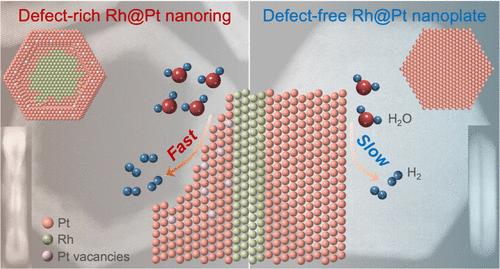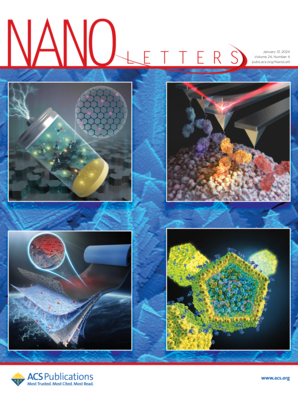Undercoordinated Two-Dimensional Pt Nanoring Stabilized by a Ring-on-Sheet Nanoheterostructure for Highly Efficient Alkaline Hydrogen Evolution Reaction
IF 9.6
1区 材料科学
Q1 CHEMISTRY, MULTIDISCIPLINARY
引用次数: 0
Abstract
Platinum (Pt) is a state-of-the-art electrocatalyst for green hydrogen production in alkaline electrolytes. The delicate design and fabrication of two-dimensional (2D) Pt nanocatalysts can significantly enhance atomic utilization efficiency, while further improving intrinsic catalytic performance by modulating the density of surface active sites. However, the high surface energy and morphology complexity of 2D nanostructures often result in poor structural stability under the working conditions. Here, we report the synthesis of a 2D ring-on-sheet nanoheterostructure featuring abundant low-coordination Pt sites in which a defect-rich Pt nanoring is stabilized by an ultrathin 2D rhodium (Rh) support. The Rh@Pt nanoring exhibits remarkably enhanced activity and stability in an electrocatalytic hydrogen evolution reaction in alkaline media compared to defect-free Rh@Pt core–shell nanoplates and commercial Pt/C. This work provides new insights for the design and synthesis of 2D nanoheterostructures with abundant surface active sites for efficient and durable electrocatalysis.

求助全文
约1分钟内获得全文
求助全文
来源期刊

Nano Letters
工程技术-材料科学:综合
CiteScore
16.80
自引率
2.80%
发文量
1182
审稿时长
1.4 months
期刊介绍:
Nano Letters serves as a dynamic platform for promptly disseminating original results in fundamental, applied, and emerging research across all facets of nanoscience and nanotechnology. A pivotal criterion for inclusion within Nano Letters is the convergence of at least two different areas or disciplines, ensuring a rich interdisciplinary scope. The journal is dedicated to fostering exploration in diverse areas, including:
- Experimental and theoretical findings on physical, chemical, and biological phenomena at the nanoscale
- Synthesis, characterization, and processing of organic, inorganic, polymer, and hybrid nanomaterials through physical, chemical, and biological methodologies
- Modeling and simulation of synthetic, assembly, and interaction processes
- Realization of integrated nanostructures and nano-engineered devices exhibiting advanced performance
- Applications of nanoscale materials in living and environmental systems
Nano Letters is committed to advancing and showcasing groundbreaking research that intersects various domains, fostering innovation and collaboration in the ever-evolving field of nanoscience and nanotechnology.
 求助内容:
求助内容: 应助结果提醒方式:
应助结果提醒方式:


